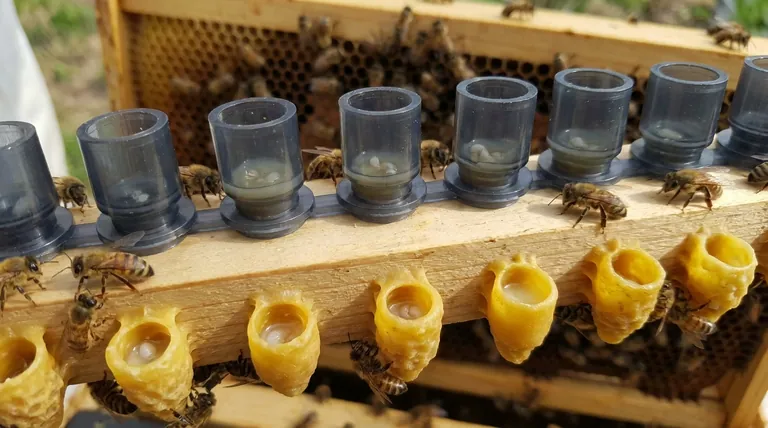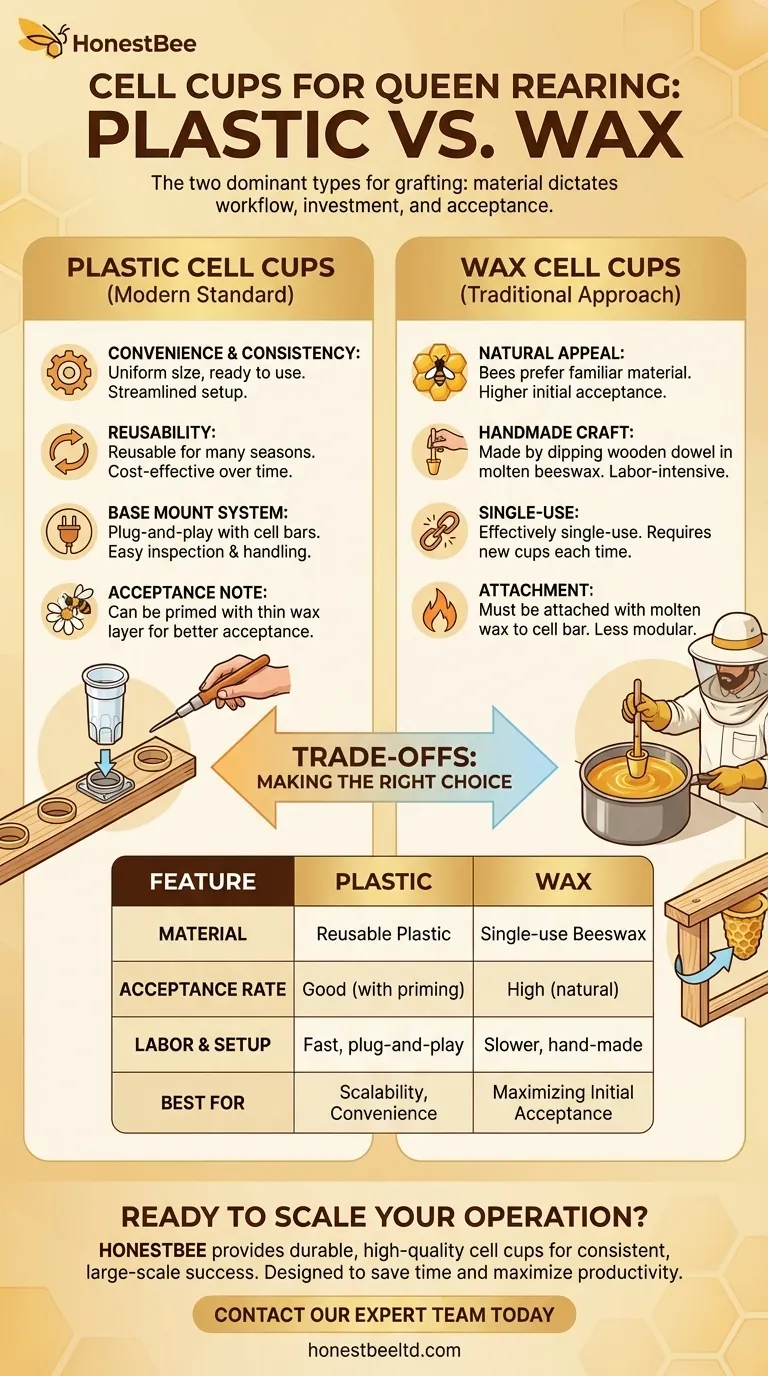In queen rearing, the two dominant types of cell cups used for grafting are commercially produced plastic cups and traditional, often handmade, wax cups. While both serve the same fundamental purpose of holding a grafted larva, their material dictates the beekeeper's workflow, initial investment, and potential acceptance rates by the nurse bees.
The choice between plastic and wax cell cups is a classic trade-off. Plastic offers unmatched convenience, scalability, and reusability, while wax provides a more natural medium that often results in higher initial acceptance rates from the bees.

A Closer Look at Plastic Cell Cups
Plastic cell cups are the modern standard for many commercial and hobbyist queen producers due to their efficiency and ease of use.
The Appeal of Convenience and Consistency
Plastic cups arrive perfectly formed and ready to use. Their uniform size and shape ensure they fit precisely into corresponding cell bar fixtures, streamlining the setup process for dozens or hundreds of grafts at a time.
Common Plastic Systems
The most prevalent style is the base mount system. In this setup, the cell cup plugs into a "cell cup base," which then plugs into a hole on the cell bar. This modular design makes it incredibly easy to inspect, handle, and transfer individual queen cells without disturbing their neighbors.
Improving Bee Acceptance
While convenient, new plastic can sometimes have lower acceptance rates than wax. Many beekeepers overcome this by "priming" the cups—either by applying a very thin coating of melted beeswax or by placing the empty cups in the hive for a day or two to let the bees polish them and coat them in hive scent.
The Traditional Approach: Wax Cell Cups
For generations, beekeepers have crafted their own cell cups from pure beeswax, a method that remains popular for its natural appeal and excellent results.
The Advantage of Natural Material
Bees are far more likely to immediately accept a larva in a cup made of a familiar, natural material. This can lead to higher success rates, especially for beekeepers who are new to grafting or for colonies that are particularly selective.
The Craft of Making Wax Cups
Making wax cups involves dipping a shaped wooden dowel of the correct diameter into molten beeswax multiple times to build up the cup's walls. While requiring more labor, this allows the beekeeper to have complete control over the quality of the wax used.
Attaching to the Cell Bar
Unlike plastic cups that plug in, wax cups must be attached to the cell bar by dipping the base of the cup into molten wax and pressing it onto the bar. This process is more time-consuming and less modular than plastic systems.
Understanding the Trade-offs: Plastic vs. Wax
Your choice depends on how you value time, cost, and scalability against the potential for slightly higher acceptance rates.
Labor and Time
Plastic is the clear winner for saving time. The plug-and-play nature of plastic systems is significantly faster than hand-making and individually mounting wax cups.
Bee Acceptance Rates
Wax generally has a higher initial acceptance rate. However, properly primed plastic cups can achieve nearly identical results after their first use, as they become coated in beeswax and hive scent.
Cost and Reusability
Plastic is more cost-effective over time. Although there's an initial purchase price, plastic cups and their mounting bases are reusable for many seasons. Wax cups are effectively single-use.
Scalability
Plastic systems are built for scale. For any operation raising more than a few queens at a time, the efficiency gained from a modular plastic system is almost a necessity.
Making the Right Choice for Your Operation
Select the cell cup that best aligns with the goals and scale of your queen rearing efforts.
- If your primary focus is convenience and scalability: Choose a plastic base-mount system for its reusability and unparalleled efficiency.
- If your primary focus is maximizing initial acceptance with natural materials: Use wax cups, whether you make them yourself or purchase them pre-made.
- If you are a beginner seeking a reliable starting point: Begin with plastic cups but be sure to prime them with a thin layer of beeswax to get the benefits of convenience with improved acceptance.
Ultimately, mastering your grafting technique and ensuring a strong, well-fed cell-builder colony will have a greater impact on your success than the material of the cup itself.
Summary Table:
| Feature | Plastic Cell Cups | Wax Cell Cups |
|---|---|---|
| Material | Reusable plastic | Single-use beeswax |
| Acceptance Rate | Good (especially when primed) | High (natural material) |
| Labor & Setup | Fast, plug-and-play system | Slower, hand-made & attached |
| Cost-Effectiveness | High (reusable for many seasons) | Lower (single-use) |
| Best For | Scalability, convenience, commercial use | Maximizing initial acceptance, natural approach |
Ready to scale your queen rearing operation with reliable, efficient equipment?
As a trusted wholesale supplier to commercial apiaries and beekeeping equipment distributors, HONESTBEE provides the durable, high-quality cell cups and systems you need for consistent, large-scale success. Our products are designed to save you time and maximize your productivity.
Contact our expert team today to discuss your specific needs and discover how our wholesale-focused solutions can benefit your business.
Visual Guide

Related Products
- Clear Black Plain Polystyrene Queen Bee Grafting Cell Cups No Lug for Bee Queen Cup
- Plastic Chinese Queen Grafting Tool for Bee Queen Rearing
- Stainless Steel Beekeeping Queen Grafting Tool for Honey Bee Rearing
- Black 2 Pack Beekeeper Queen Grafting Tool for Bee Queen Larva Transferring Needle
- Queen Bee Marking Pen UNI Medium Point for Queen and Bee Marking
People Also Ask
- What can be done with other bars of cells after grafting? Master Post-Grafting Queen Rearing
- What should be done before inserting freshly grafted or started cells? Ensure High Queen Acceptance Rates
- What are signs that bees have not accepted a new queen? Spot Rejection Early to Protect Your Hive
- What should be done if brace comb is built between cells before adding cages? A Guide to Safe Queen Cell Surgery
- How do bees typically destroy a queen cell? A Guide to Successful Queen Rearing









